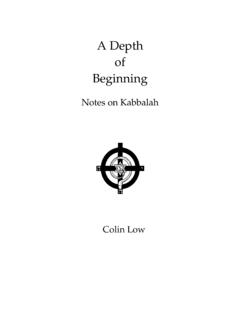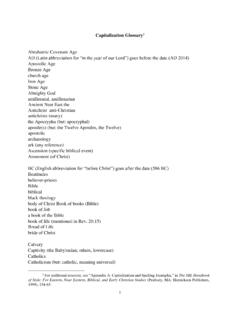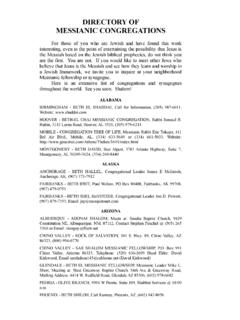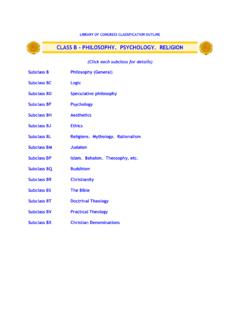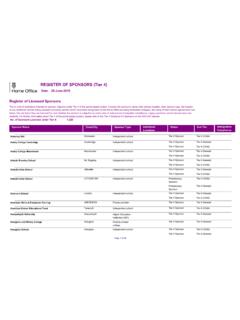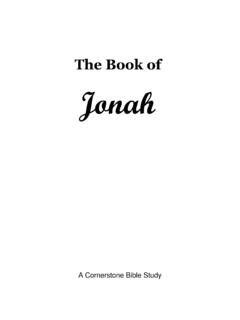Transcription of The Zohar in English
1 Don Karr 2019. Notes on the Zohar in English Don Karr Don Karr, 1985, 1995, updated 2001-2010, revised and updated 2011-2019. Email: All rights reserved. License to Copy This publication is intended for personal use only. Paper copies may be made for personal use. With this exception, no part of this publication may be reproduced or transmitted in any form or by any means, electronic or mechanical, including photocopy, without permission in writing from the author. Reviewers may quote brief passages. The original version of this paper appeared in Collected Articles on the Kabbalah, volume 1, by D. Karr (Ithaca, KoM #5, 1985: pp. 21-28). THE Zohar , or Sefer ha- Zohar (BOOK OF SPLENDOR), is without question the major text of classical Kabbalah. It is not a single book, but rather a collection of tracts of various sizes, there being about two dozen which form fairly coherent units.
2 The bulk of the Zohar is a running commentary on the Torah, into which the numerous shorter tracts have been incorporated, added in the margins, or compiled as addenda to the various chapters. Some of the shorter tracts are in a separate section called the Zohar Hadash (the NEW Zohar ), and there is yet a third section called the Tikkunei Zohar (the ARRANGEMENTS OF THE Zohar ). Research concerning the authorship and chronology of the zoharic strata is on-going, though most scholars agree that the main body of the Zohar was written by Rabbi Moses de Leon (1250-1305) and perhaps some others in his circle toward the end of the thirteenth century into the beginning of the fourteenth. Later strata (Raya Mehemna and the Tikkunim), were written in the fourteenth century and added to de Leon's 1 On the authorship of the Zohar , see Yehuda Liebes, How the Zohar Was Written, in Studies in the Zohar (Albany: State University of New York Press, 1993).
3 Regarding the Zohar 's internal chronology and its subsequent collection and publication, the most recent work has been published in Hebrew articles by Ronit Meroz and Boaz Huss; however, note the English articles by Meroz and Huss in the bibliography below. On the evolution of the Zohar as a text, see Boaz Huss, The Zohar : Reception and Impact (Oxford . Portland: The Littman Library of Jewish Civilization, 2016), especially CHAPTER 2, The Zohar as Imagined Book, and CHAPTER 3, The Formation of the Zoharic Canon, pages 36-111. Further, on whether the Zohar was originally a unified literary unit, , a book, see Daniel Abrams, Critical and Post-Critical Textual Scholarship of Jewish Mystical Literature: Notes on the History and Development of Modern Editing Techniques, in Kabbalah: Journal for the Study of Jewish Mystical Texts, vol.
4 1, edited by D. Abrams and A. Elqayam (Los Angeles: Cherub Press, 1996), and Abrams' The Invention of the Zohar as a Book On the Assumptions and Expectations of the 1. Don Karr 2019. Two publications which can viably claim to be complete editions of the Zohar in English have been published (1 and 2), and another has been promised (3); see below regarding the following editions: (1) the Kabbalah Centre International (2) Stanford University (= the PRITZKER EDITION). (3) Fiftieth Gate Publications Before the Kabbalah Centre edition of the Zohar of 2001, somewhere between two- thirds and three-quarters of the Zohar had been put into English , and that spread over a handful of separate publications which varied greatly in method and quality. This paper is divided into six sections: 1.
5 SOURCES OF THE Zohar IN English TRANSLATION. 2. DIVISIONS OF THE Zohar : a chart showing the different tracts and sections of the Zohar along with initial-coded entries to indicate books which contain translations of them 3. PARASHAT/ Zohar chart 4. BIBLIOGRAPHY with notes, listing books, sections of books, and articles which discuss the Zohar or some aspect of it; many of these items contain translated passages 5. RECOMMENDATIONS concerning the pursuit of Zohar study in English 6. Zohar I 51b-52a translated from the French of Jean de Pauly Kabbalists and Modern Scholars, in Kabbalah: Journal for the Study of Jewish Mystical Texts, vol. 19, edited by Daniel Abrams (Los Angeles: Cherub Press, 2009), pages 7-142. Many of Abrams' articles have been collected and expanded upon in his 743-page Kabbalistic Manuscripts and Textual Theory: Methodologies of Textual Scholarship and Editorial Practice in the Study of Jewish Mysticism (Los Angeles: Cherub Press Jerusalem: The Magnes Press, 2010; revised and expanded edition, 2014); regarding the Zohar , see CHAPTER 4, The Invention of the Zohar as a Book.
6 A fairly recent Overview of Zohar Research appears in Melila Hellner-Eshed, A River Flows from Eden: The Language of Mystical Experience in the Zohar (Stanford: Stanford University Press, 2009): pages 23-28. On translations of the Zohar not limited to English see Boaz Huss, Translations of the Zohar : Historical Contexts and Ideological Frameworks, in Correspondences: Online Journal for the Academic Study of Western Esotericism 4 (2016), pages 81-128: 2. Don Karr 2019. 1. SOURCES OF THE Zohar IN English TRANSLATION. The most comprehensive guide to the Zohar is Isaiah Tishby's Wisdom of the Zohar , the English version of which came out in The Hebrew original, Mishnat ha- Zohar , has been a standard, lauded by scholars since its publication: volume 1 in 1949. and volume 2 in 1961.
7 In form, Wisdom is an anthology of Zohar readings arranged by subject. Each subject is thoroughly and clearly introduced; each translated passage is supported by full explanatory footnotes. While most excerpts are a page or two in length, a few are quite extensive, such as the full translations of the section Yanuka (i on the divisions chart), major portions of Sava (h on the chart), and the first of the two Hekhalot sections (f on the chart). (Wisdom is keyed as IT on the chart.). The principal virtue of Tishby's rich study is the organization which it lends to the Zohar by bringing together passages on similar or related subjects which, in the printed editions, are scattered all over the place and by offering such complete and lucid introductions. In giving the reader so much help, Tishby makes the concepts of the Zohar , many of which are quite difficult and obscure, far more accessible than they would be from a translation standing alone.
8 The work which, from the 'thirties until rather recently, presented the largest amount of the Zohar in English (maybe two thirds) is the five-volume translation of Maurice Simon, Harry Sperling, and Paul P. Levertoff,3 The Zohar , with an introduction by Dr. J. Abelson (Soncino Press, 1931-4, and a student edition by Rebecca Bennet Publications frequently reprinted; keyed on the divisions chart as SSL). This set is often referred to as The Soncino Clearly, SSL's idea was to present a coherent linear commentary to the Torah, but their omissions leave the reader frustrated. Missing are not only most of the inserted tracts but also many of the particularly difficult passages from the running commentary itself. Introductory material and notes are minimal. Gershom Scholem (in Major Trends in Jewish Mysticism, p.)
9 387, n. 34) says of SSL, This translation is not always correct but it conveys a clear impression of what the Zohar is. It is to be regretted that too much has been omitted. The innumerable deliberate falsifications of the French translator, Jean de Pauly, are of course not to be found in this more solid and workmanlike translation. 2 Complete publication information on this and all other books which are discussed in this section is given in 3. BIBLIOGRAPHY. 3 See Elliot R. Wolfson's article, Paul Philip Levertoff and the Popularization of Kabbalah as a Missionizing Tactic, in Kabbalah: Journal for the Study of Jewish Mystical Texts, Volume Twenty-Seven, Special Issue: KABBALAH ON THE MARGINS TRANSFORMATIONS OF KABBALAH IN ASHKENAZI. SOCIETIES, edited by Daniel Abrams with guest editors Nathaniel Deutsch and Jean Baumgarten (Los Angeles: Cherub Press, 2012).
10 4 The Soncino Zohar has been produced on CD-ROM for both Mac and Windows. This eZohar, which is the same as the printed books, can be gotten alone or on a CD-ROM, Soncino Classics Collection, which also includes an extensive selection of texts in both Hebrew/Aramaic and English : the Bible, the Talmud, and midrash Rabba; the commentaries of Rashi on the Talmud and Chumash, and the Tosafot on the Talmud are in Hebrew only. The Soncino Zohar requires 128 MB RAM , CD-ROM drive, and GB. free hard drive space for installation. On the Internet, go to 3. Don Karr 2019. Daniel Matt's comments on SSL: The older English translation composed in the nineteen-thirties reads smoothly but often misunderstands the text. Its genteel prose is more paraphrase than accurate translation, avoiding unfamiliar terms, censoring erotic material, skipping difficult passages even entire sections.

